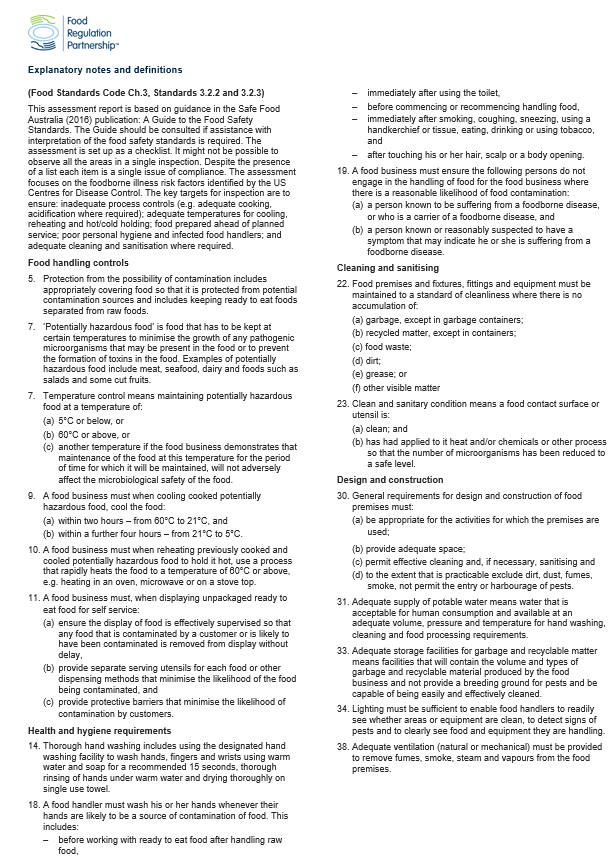Title Page
-
Trading name
-
Proprietor/Company
-
Email
-
Phone
-
ABN
-
Conducted on
-
Prepared by
-
Location
-
INSTRUCTIONS
1. Answer the questions provided below.
2. Add Photos and Notes by clicking on the Paperclip icon.
3. To add a Corrective Measure click on the Paperclip icon then "Add Action", provide a description, assign to a member, set priority, and due date.
4. Complete audit by providing digital signature.
5. Share your report by exporting as PDF, Word, Excel or Web Link.
Other Information
-
Business details
-
FSS name
-
FSS Cert no.
-
General requirements
-
1 Food business has notified current details Standard 3.2.2 clause 4
-
2 If needed, FSS is appointed and certificate is on the premises Food Act 2003 s.106
-
3 Food handlers have skills & knowledge to handle food safely Standard 3.2.2 clause 3
-
Score
-
4 No handling or sale of unsafe or unsuitable food eg food that is damaged, deteriorated or perished; no use of cracked or dirty eggs or food past use by date Food Act 2003 s.16/17
Food handling controls FSS 3.2.2
-
5 Food protected from the possibility of contamination; food receipt, storage, preparation, display and transport clause 5(1), 6(1), 7(1)(b)(i), (8(1)-(4) and 10(a)
-
Score
-
6 Names and addresses are available for manufacturer, supplier or importer of food clause 5(2)
-
7 Potentially hazardous food (PHF) is under temperature control: food receipt, storage, display and transport; less than 5°C or above 60°C. Frozen food is hard frozen cl 5(3), 6(2), 8(5) and 10(b) and (c)
-
Score
-
8 Processing of foods; take all practicable measures to process only safe and suitable food; prevent likelihood of contamination; use process step if necessary clause 7(1)
-
Score
-
9 Cooked PHF is cooled rapidly (2+4 hr rule); items thawed correctly; processed quickly; clause 7(2) and (3)
-
Score
-
10 Reheating of PHF is rapid – oven, stove top or microwave but not bain marie clause 7(4)
-
11 Self serve food bar is supervised, has separate utensils and sneeze guard clause 8(2)
-
12 Food wraps and containers will not cause contamination clause 9
-
13 Food for disposal is identified & separated from normal stock clause 11
Health and hygiene FSS 3.2.2
-
14 Food handlers wash and dry hands thoroughly using hand wash facilities clause 15(4)
-
15 Food handlers avoid unnecessary contact with ready-to-eat food or food contact surfaces by use of utensils, a gloved hand, food wraps clause 15(1)(b) and 18 (3)(b)
-
16 Food handlers do not spit or smoke in food handling areas or eat, sneeze, blow or cough over exposed food or food contact surfaces clause 15(1)(e)-(g) and clause 18(3)(c)
-
17 Food handlers take all practical measures not to contaminate food/surfaces; have clean clothing, waterproof bandages cl 15(1)(a) and (c) and 18(3)(a)
-
18 Food handlers wash hands when contaminated; before commencing/recommencing work and after: using the toilet, sneezing, smoking, handling raw meat, cleaning clause 15(2) and (3)
-
19 Food handlers do not handle food if ill (vomiting, gastro) clause 14 and 16
-
20 Hand washing facilities easily accessible and used only for washing of hands, arms and face clause 17 (1)
-
21 Hand washing facilities have warm running water through single spout, single use towels and soap clause 17(1)
-
Score
Cleaning and sanitising FSS 3.2.2
-
22 Premises, fixtures, fittings and equipment maintained to an appropriate standard of cleanliness clause 19
-
Score
-
23 Food contact surfaces, eating and drinking utensils in a clean and sanitary condition/appropriate sanitising method in use (chemicals or dishwasher) clause 20
-
Score
Temperature measuring device / single use items FSS 3.2.2
-
24 Accurate temperature measuring device readily accessible (digital probe thermometer – accurate to +/- 1°C) clause 22
-
25 Single use items protected from contamination and not reused (drinking straws, disposable utensils) clause 23
Animal and pests FSS 3.2.2
-
26 Animals not permitted in areas in which food is handled clause 24 (1)(a)
-
27 Practical pest exclusion measures used (screens, seals) clause 24(1)(b)
-
28 Practical measures to eradicate and prevent harbourage of pests used (housekeeping, stock rotation, pest controller) clause 24(1)(c)
-
29 Signs of insect infestation or rodent activity in premises (faeces, egg casings, teeth marks) clause 24(1)
-
Score
Design and construction FSS 3.2.3
-
30 General design and construction of premises appropriate
-
31 Supply of potable water available
-
32 Effective sewerage and waste water disposal system
-
33 Adequate storage facilities for garbage and recyclables
-
34 Premises has sufficient lighting
-
35 Floors are able to be effectively cleaned, appropriately designed and constructed and don’t permit harbourage for pests
-
36 Walls, ceilings are sealed and able to be effectively cleaned, appropriately designed and constructed and don’t permit harbourage for pests
-
37 Fixtures, fittings and equipment are able to be effectively cleaned, fit for their intended use, and designed, constructed, located and installed appropriately
-
38 Sufficient ventilation provided within the premises
-
39 Adequate storage facilities (personal items, chemicals, food)
Maintenance FSS 3.2.2 cl 21
-
40 Premises, fixtures, fittings and equipment in a good state of repair and working order
-
41 No chipped, broken or cracked eating or drinking utensils
Miscellaneous
-
42 Food labelling complies with the Food Standards Code, 1.2
-
43 For ‘Standard Food Outlet’, nutrition information displayed
-
44 Food business is aware of the Raw Egg Guideline
-
45 Food business is aware of its obligations regarding allergens
Completion
-
Overall grade
-
Scores on Doors certificate issued
-
FPAR
-
Select the appropriate response
- Business satisfactory
- Further action required
- Re-inspection
- Warning Letter
- Improvement Notice
- Prohibition Order
- Penalty Notice
- Other
-
Please specify Other
-
I have read this report and understand the contents.
-
Owner/Employee Name and Signature
-
Officer’s Name and Signature







